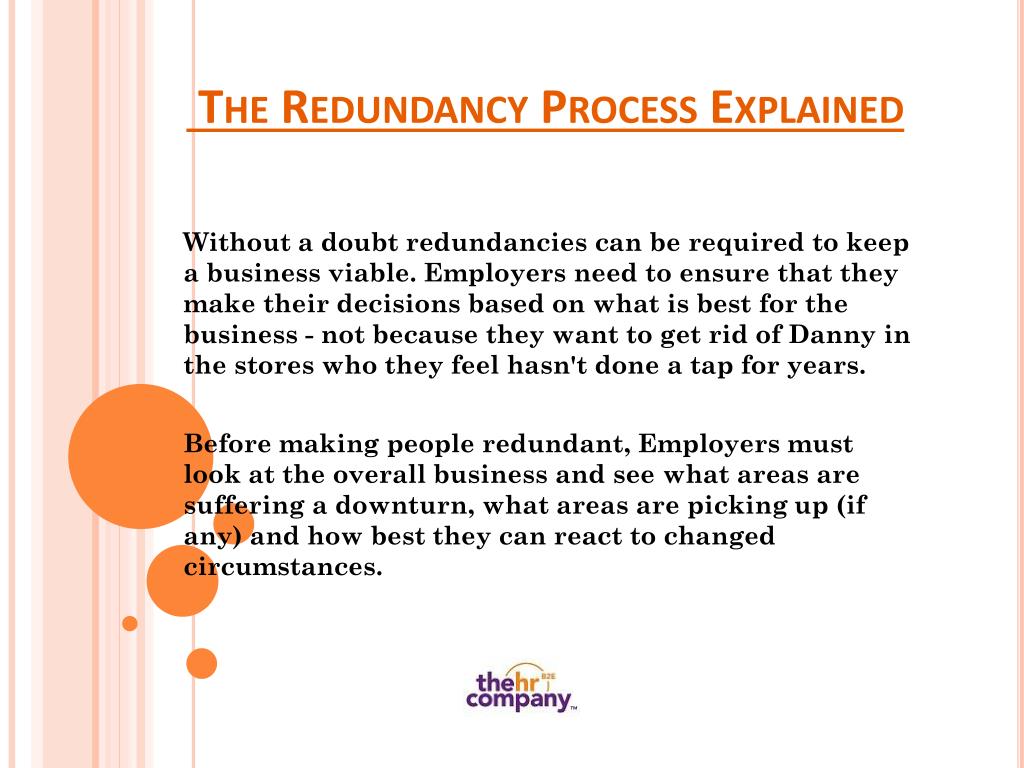Who Pays Redundancy Money? Recognizing Employer Duties in the UK
Who Pays Redundancy Money? Recognizing Employer Duties in the UK
Blog Article
Assessing the Systems of Company Redundancy and Its Influence on Employee Spirits
The mechanisms behind the decision-making procedures leading to staff member redundancies can have far-reaching effects on morale within a company. By exploring the complex interaction in between company scaling down strategies, staff member responses, and organizational resilience, a more clear photo arises of the elaborate dance between service demands and human feelings.

Impact of Firm Redundancy on Spirits
The significant rise in business redundancies has had a profound influence on employee spirits in recent months. As organizations browse financial difficulties, the choice to scale down or restructure procedures typically results in enhanced degrees of uncertainty and stress and anxiety amongst workers. The fear of losing one's job, paired with the boosted work for remaining team, can produce a stressful job environment that wets morale.
Workers that witness their colleagues being given up may experience survivor shame, feeling grateful for their own placement while additionally facing sensations of sadness and instability. This psychological turmoil can adversely influence efficiency and engagement, as people battle to concentrate among the upheaval.
Furthermore, the absence of transparency bordering the redundancy process can better deteriorate count on and confidence in business management. if a company goes bust who pays redundancy. When workers feel unenlightened or overlooked throughout such unstable times, their commitment to the company reduces, and morale plummets
Elements Resulting In Firm Downsizing
Amidst financial uncertainties, firms typically deal with the tough job of recognizing and attending to key elements that necessitate downsizing their procedures. One significant variable bring about firm downsizing is financial instability. When a company experiences monetary troubles such as decreasing earnings, raising costs, or excessive financial obligation, scaling down might end up being a required procedure to make sure the company's sustainability. Technological innovations likewise play a critical function in company downsizing. Automation and the fostering of more effective processes can bring about a minimized demand for human labor, causing workforce decreases. Market changes and adjustments in customer choices are extra factors that can activate scaling down efforts. Firms need to adjust to developing market conditions to stay competitive, and this sometimes involves restructuring procedures and minimizing labor force dimension. Additionally, mergings and procurements can bring about redundancies, triggering companies to downsize to get rid of overlapping duties and improve operations. Generally, a mix of financial difficulties, technological changes, market dynamics, and organizational changes typically drive business in the direction of downsizing as a calculated decision.
Methods for Reducing Negative Effects
Factors leading to company scaling down necessitate the application of critical steps aimed at reducing the unfavorable results on both the organization and its staff members. Clear interaction aids staff members understand the reasons behind the redundancy, minimizes uncertainty, and decreases anxiety.
An additional important method is to prioritize staff member wellness during and after the downsizing duration. This consists of supplying accessibility to counseling services, producing a supportive setting for those continuing to be in the company, and providing opportunities for upskilling or re-training to improve their employability. In addition, rewarding the commitment and identifying and effort of workers that stay can aid preserve motivation and prevent a decrease in morale. By implementing these approaches, companies can browse scaling down with more concern and minimize the adverse influence on worker morale.
Worker Durability Amidst Redundancy
Navigating with periods of redundancy, employees are commonly needed to demonstrate resilience despite organizational changes. Worker resilience amidst redundancy describes the capacity of individuals to adapt, go to this website cope, and jump back from the challenges presented by prospective task loss. This durability can materialize in different methods, such as keeping a positive perspective, choosing new opportunities, upskilling, and networking to enhance employability.
Durable workers usually display a growth mindset, watching setbacks as temporary and concentrating on understanding and development. They are proactive in managing their emotions, looking for assistance when required, and preserving a sense of positive outlook regarding the future. Additionally, resistant employees are a lot more most likely to accept change, see it as a possibility for expert and individual growth, and remain fully commited to their job progression regardless of the uncertainty produced by redundancy.
Organizations can support staff member durability with transparent interaction, providing accessibility to resources for upskilling and re-training, using career counseling solutions, and identifying and rewarding staff members that demonstrate strength during difficult times. By cultivating a society of strength, firms can assist staff members browse redundancy better and emerge stronger from the experience.
Building an Encouraged Labor Force Post-Redundancy
In the after-effects of organizational restructuring and worker resilience among redundancy, promoting a determined workforce ends up being vital for the firm's future success and staff member well-being. Building a determined workforce post-redundancy calls for a calculated approach that concentrates on restoring count on, increasing spirits, and re-engaging employees. Interaction plays a pivotal function in this process, as open and clear dialogue can help workers understand the reasons behind the redundancies and the company's vision progressing.
Giving chances for staff member advancement and development is another critical facet of developing a motivated workforce post-redundancy. Offering training programs, mentorship chances, and occupation innovation prospects can help staff members really feel valued and purchased their future within the company - if a company goes bust who pays redundancy. Acknowledging and rewarding staff members for their contributions, specifically during challenging times, can also increase spirits and motivation

Final Thought
Finally, company redundancy can have a considerable influence on employee morale, resulting in lowered motivation and job fulfillment. Understanding the factors that add to downsizing and executing strategies to minimize adverse effects is essential for keeping staff member strength throughout difficult times. By promoting a supportive work atmosphere and supplying chances for expert growth, companies can reconstruct a motivated labor force post-redundancy.
The significant boost in company redundancies has actually had a profound influence on worker spirits in recent months. By implementing these approaches, companies can navigate scaling down with more concern and mitigate the unfavorable influence on employee spirits.
In the aftermath of business restructuring and worker durability amidst redundancy, fostering a determined labor force ends up being paramount for the business's future success and staff member wellness. Communication plays an essential duty in this procedure, as transparent and open discussion can help employees recognize the factors behind the redundancies and the firm's vision moving forward.
In final thought, company redundancy can have a considerable effect on employee morale, leading to lowered inspiration and task contentment. (if a company goes bust who pays redundancy)
Report this page